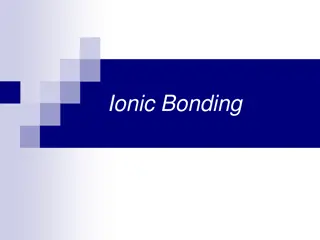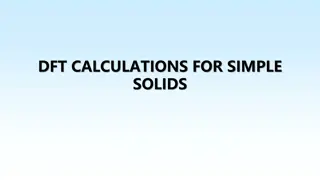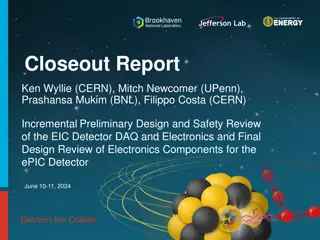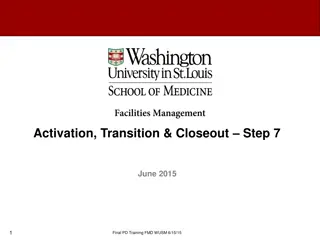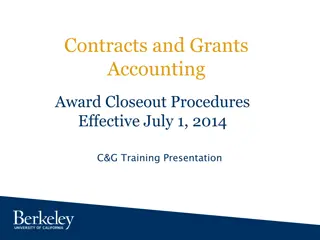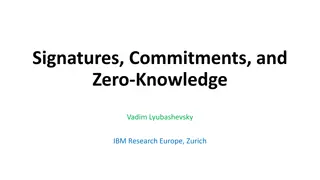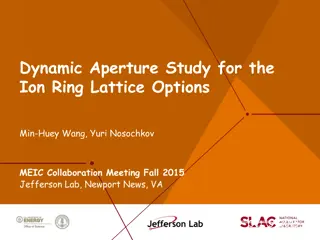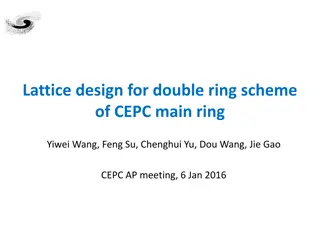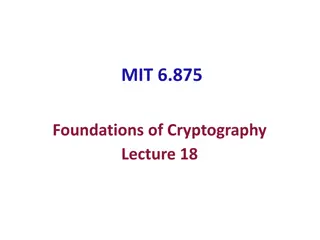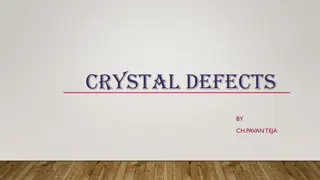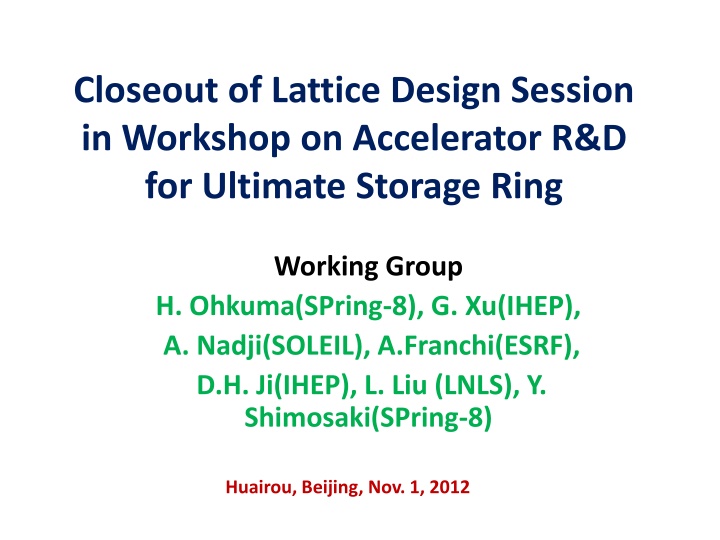
Exploration of Ultimate Storage Ring Designs and Upgrades
Delve into lattice design sessions and talks on accelerator R&D for ultimate storage ring projects, covering upgrades, low emittance studies, and future synchrotron light sources. Topics include diffraction-limited emittance goals, necessary technologies like damping wigglers, and optimization strategies for achieving high brilliance and coherence.
Download Presentation

Please find below an Image/Link to download the presentation.
The content on the website is provided AS IS for your information and personal use only. It may not be sold, licensed, or shared on other websites without obtaining consent from the author. If you encounter any issues during the download, it is possible that the publisher has removed the file from their server.
You are allowed to download the files provided on this website for personal or commercial use, subject to the condition that they are used lawfully. All files are the property of their respective owners.
The content on the website is provided AS IS for your information and personal use only. It may not be sold, licensed, or shared on other websites without obtaining consent from the author.
E N D
Presentation Transcript
Closeout of Lattice Design Session in Workshop on Accelerator R&D for Ultimate Storage Ring Working Group H. Ohkuma(SPring-8), G. Xu(IHEP), A. Nadji(SOLEIL), A.Franchi(ESRF), D.H. Ji(IHEP), L. Liu (LNLS), Y. Shimosaki(SPring-8) Huairou, Beijing, Nov. 1, 2012
Summary of Talks(1) Lattice Design for the MAX IV 3 GeV Storage Ring by S. Leemann (MAX- Lab) E = 3 GeV, 7BA, x = 326 pm.rad w/o IDs. I = 500mA |DA| = 7-10mm with error Number of straight = 20 ~5m Circumference = 528m Upgrade of the ESRF Light Source : Achievements and Perspectives by P. Raimondi (ESRF) Accelerator Upgrade Phase I (6m, 7m straight sections), Top-up project E=6GeV, C=844, 7BA, = 130 pm.rad, SS 32x5m Lattice Design for SPring-8 II by Y. Shimosaki (SPring-8) E=6GeV, C=1436m, 6BA, = 67.5 pm.rad, SS: 44 4.5m, 4 27m with FODO Possible USR Upgrade of the ALS by C Steier (LBNL) ALS-II: 5BA-7BA, 50-100pm.rad, . E=2GeV, C=250m(?)
Summary of Talks(2) Study of Lower Emittance Lattice at SOLEIL by A. Nadji (SOLEIL) (Short term path) : Robinson Wiggler in a non-zero horizontal dispersion straight section Beam Adapter in the 12 m long straight section (Long term path) : USR is also considered ( x 400pm.rad) BAPS Lattice Design by G. Xu (IHEP) E=5GeV, C=1364.8m, 7BA, = 51 pm.rad, SS: 10 (15BA, 6BA also considered) 7m, 36 7m A compact low emittance lattice with superbends for Sirius by L. Liu (LNLS) E=3GeV, C=518.2m, 5BA+SB(2T), x = 280 pm.rad, SS: 10 DA = +-10mm(AC20 mode), +-5mm(AC10 mode) with align-error. Permanent magnet dipoles 7m, 10 6m Future Synchrotron Light Sources Based on Ultimate Storage Rings by (Y. Cai) M. Borland (ANL) PEP-X : E=4.5GeV, 7BA, C=2199.32m, x = y = 12 pm.rad, SS: 5m DA = +-10mm with error of 20 m
Summary of Talks(3) Exploration of a Tevatron-Sized Ultimate Light Source by M. Borland (ANL) E=9GeV, C=6210m, 180 IDs, = 2.98pmrad, Coupling factor ~ 100% |DA|=+-0.8mm (that may improve with more running time of MOGA). APS-II E=6GeV, 7BA, = 147 pm.rad, Overview of optics corrections at Diamond and plans for Diamond-II by R. Bartolini (DLS) DLS-II : E=3GeV, C=561.6m, modified 4BA, = 314.7 pm.rad, 9.7m, 6.7m, 3m 5BA, = 142.5 pm.rad, SS: 9.5m, 6.5m 7BA, = 45.7 pm.rad, SS: 8.0m, 5.0m Round beams experience at BINP and other ideas by E. Levichev (BINP) Round beam mode in the sense of VEPP-2000 (1D motion at IP) seems has no advantage for USR Equal emittances concept to reach a diffraction limit emittance in both planes seems promissing and should be studied in details. Damping wigglers with horizontal magnetic field look attractive for rounding the emittances and to suppress additionally any heating of the beam emittances.
Main Subjects (1) What is USR? : a storage ring having an emittance in both transverse planes at the diffraction limit for a range of wavelength? : diffracted limited emittance is /4 or /2 ? : for example, 1A-USR or 10A-USR or even Soft X-ray USR or Hard X-ray-USR? : Very high brilliance or very high coherence? Target Emittance : 10pm.rad ? , diffraction limited @ 10KeV? : Damping Wiggler and/or coupling control etc. is needed : The low field of the dipoles help for low energy dispersion, also very desired to optimize the brilliance of long insertion device : The use of defocusing gradient in the dipoles helps : The use of longitudinally variable field also helps Energy Spread
Main Subjects (2) MBA : Optimized No. ? : seems to be the best compromise to reach ultra low emittance and zero dispersion straight sections. : M is a compromise between the emittance we want to reach and the number of straights needed Energy (3GeV-9GeV) : depending on user s demands and required max. photon energy. Future ID development Dynamic Aperture: need for Injection and beam lifetime : Adequate dynamic aperture and beam lifetime should be possible (push the idea of resonance cancellation and use of high order multipoles)
Main Subjects (3) Modern lattice optimization : using multi-objective genetic algorithms (MOGA) : Phase advance between sextupoles IBS, collective effects & Touschek : most serious issue Harmonic Cavity for longer lifetime and higher bunch current (SP8-II, and others). Combined function magnets : because of compactness (MAX-IV, others) Alignment: Requirement < 10 m Small aperture vacuum chamber : NEG-coated Cu chamber (MAX-IV, Sirius)
Main Subjects (4) Matching between the electron and photon phase space should be a criteria to maximize the brilliance Can we define a quality factor : How far the lattice is optimized in term of emittance normalized to the energy, circumference and length for straight sections? It is for specific and exigent users : keep high stability and reliability The Lattice design has to provide low emittance AND adequate space in straight sections to accommodate Insertion Devices
We would like to thank all the speakers. S. Leeman (Max-lab) P. Raimondi (ESRF) Y. Shimosaki (SPring-8) C Steier (LBNL) A. Nadji (SOLEIL) G. Xu (IHEP) L. Liu (LNLS) (Y. Cai (SLAC)) M. Borland (ANL) R. Bartolini (DLS) E. Levichev (BINP)


